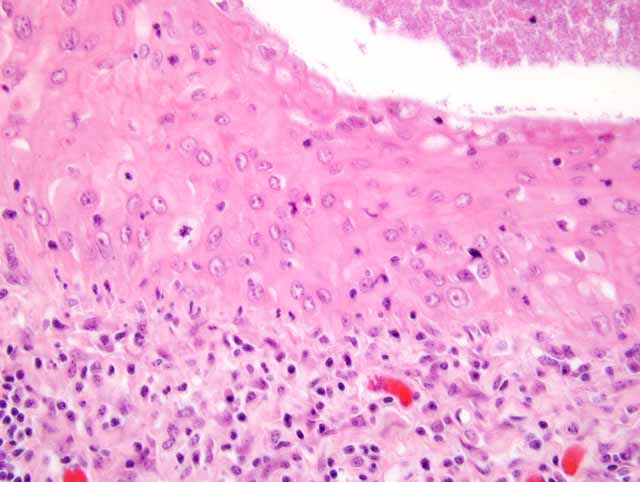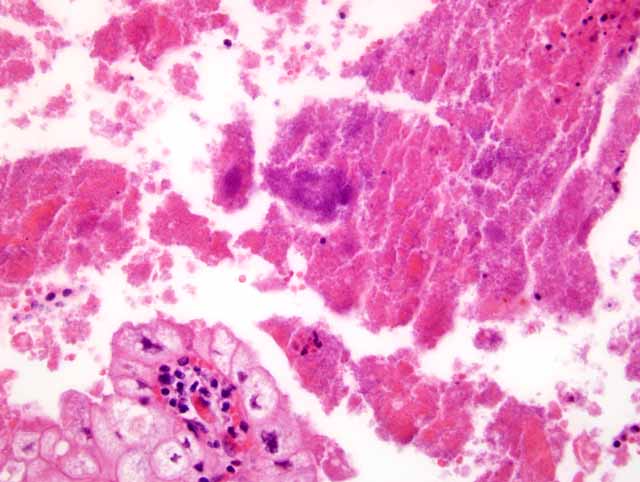Signalment:
Gross Description:
Histopathologic Description:
Morphologic Diagnosis:
Lab Results:
Bacteriology
-Placenta: Cellulosimicrobium cellulans formerly known as Oerskovia xanthineolytica (numerous)
-FA testing for the detection of Leptospira interrogans on the placenta was negative.Â
Condition:
Contributor Comment:
Given the presence of an exudative placentitis, the distribution of the placental lesions, and the characteristics of Cellulosimicrobium cellulans, there are similarities between the bacteria described here and placentitis resultant of a Crossiella equi infection. Pyogranulomatous pneumonia, as seen with Cellulosimicrobium cellulans, does not accompany nocardioform placentitis.
Common bacterial agents resulting in placentitis and abortion in the horse include Leptospira spp, nocardioform, Escherichia coli, Streptococcus zooepidemicus, Pseudomonas aeruginosa, Streptococcus equisimilis, Enterobacter agglomerans, Klebsiella pneumoniae, and alpha- hemolytic Streptococcus.(2)
JPC Diagnosis:
Conference Comment:
The bulk of the conference discussion centered on the outbreak of abortions in Kentucky in the spring of 2001 and 2002 dubbed Mare Reproductive Loss Syndrome (MRLS). MRLS caused large numbers of abortions reaching epidemic proportions in Kentucky.(4) The economic loss alone has been estimated at almost $500 million.Â
Mares with MRLS abort late in gestation or at term and the fetuses are still enclosed within the placenta and in good condition. Mares show no overt clinical illness prior to abortion. In the fetus, gross lesions include hemorrhages in the chorion, amnion, and amniotic segment of the umbilical cord, pleura, and heart, hypema, and uninflated lungs. Additionally, the amniotic cord is often dull gray and thickened. Histologically, macrophages and neutrophils are seen in ulcerated areas on the surface of the amniotic cord in association with bacteria. The allantochorion also has similar lesions. Funisitis, amnionitis, pneumonia, fetal bacteremia, and chorionitis are also evident microscopically.Â
The most commonly implicated cause for MRLS is the eastern tent caterpillar (ETC). Feeding of the eastern tent caterpillar to pigs has resulted in abortions in one study. Similar studies in horses have demonstrated that the feeding of the exoskeleton of the eastern tent caterpillar causes abortion in mares. One of the most current hypotheses is that a portion of the caterpillar cuticle is responsible for its abortifacient effects.(4)
References:
2. Hong CB, Donahue JB, Giles RC, Petrites-Murphy MB, Poonacha KB, Roberts AW, Smith BJ, Tramontin RR, Tuttle PA, Swerczek TW: Etiology and pathology of equine placentitis. J Vet Diagn Invest 5:56-63, 1993
3. Rihs JD, McNeil MM, Brown JM, Yu VL: Oerskovia xanthineolytica implicated in peritonitis associated with peritoneal dialysis: case report and review of Oerskovia infections in humans. J Clin Microbiol 28:1934-1937, 1990
4. Schlafer DH, Miller RB: Female genital system. In: Jubb, Kennedy, and Palmer's Pathology of Domestic Animals, ed. Maxie MG, vol 3, pp. 506-507. Elsevier Limited, Philadelphia, PA, 2007

